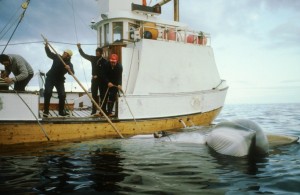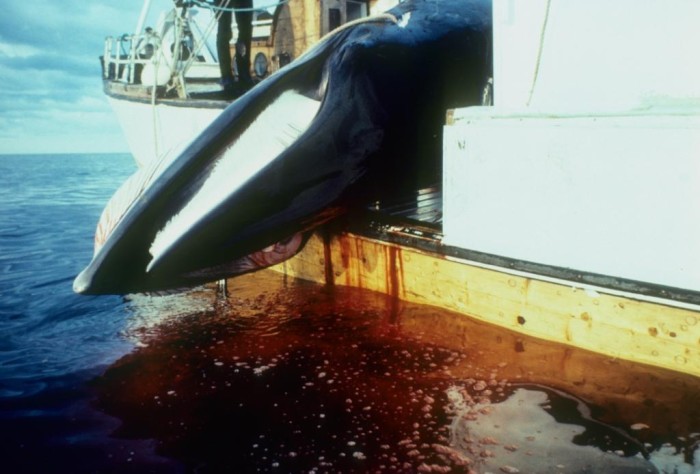The Norway whaling probe that led to EIA’s creation



.Some 30 years ago, in June 1983, I was aboard the 116ft North Sea trawler the Balaenoptera with a wonderful crew of volunteers. Our aim was to document Norwegian whaling – something no-one had done before.
The momentous decision to end all commercial whaling by 1986 had been made the year before by the International Whaling Commission (IWC). In addition, in 1981 the IWC banned the ‘cold’ non-explosive harpoons because, designed to secure and wound whales rather than kill them outright, it was just too cruel.
This remarkable venture came about over a nice cup of tea with Allan Thornton, who suggested buying a boat and sailing to Norway to document its whaling.
Neither of us had any money but within a few days a very determined Allan had raised funds; having never aspired to owning a North Sea trawler, I found it surreal that we now did. It changed my life for good.
Delivering the boat from Aberdeen to London taught me just how horrible the North Sea can be aboard a trawler, with the best respite being a turn at the wheel. In what was then the ghostly West India Dock, work started on the Balaenoptera’s makeover. Favours were called in from several of Allan’s Rainbow Warrior friends and soon the vessel was looking very smart, particularly the huge minke whales painted either side of the bow by Peter Currey.
Aboard the boat I met a funny chap with a big beard and a long blond ponytail busily painting and liked him instantly; he was Dave Currey and little did we know we would end up being friends for life and, with Allan, the founders of EIA
Former Rainbow Warrior captain John Castle was persuaded to take the same role with us; Andy Mallion was so determined to be second mate that he moved onto the boat without interview; he was qualified and loved whales, so we were happy.
Rainbow Warrior veteran Athel von Koettlitz was our Chief Engineer, accompanied by Bart Janssen and Jos van Heumen in the engine room.
Raphael Demandre, John Booth, Allan, Dave and I made up the rest of crew, Dave very reluctantly agreeing to be photographer after being sea sick his entire time aboard the Rainbow Warrior.
After a press conference at Tower Pier, we set sail down the Thames and over to Scheveningen, where the boat was put in dry dock for hull-cleaning and painting. Final preparations and last-minute provisions done, we set sail with for Bergen.
 Northern Norway
Northern NorwayWe arrived in Northern Norway inside the Arctic Circle with 24-hour daylight after sailing through the gorgeous Lofoten Islands. This heart of the Norwegian whaling industry made me sad as I contemplated just how many whales had been killed around these islands.
We wanted to investigate how the whaling business operated, so Allan suggested Dave and I go ashore in the key whaling port of Vardø to have a look around. We were dropped off on a small private jetty on a very wet early Sunday morning. Scaling a locked 15ft gate, we decided to drop in at the local police station in case we’d been spotted.
The policeman seemed confused by the odd English pair in his office. He was pleased to see us but like many others we met during the day, almost disappointed that we were not from Greenpeace when we explained we were journalists investigating the Norwegian fishing and whaling industries.
Scouting the town, we soon spotted boxes in a window bearing a picture of a whale, marked ‘whale meat’ and bound for Tokyo. Things were looking up as we found our first whale meat processing factory to be a hive of activity.
Inside, we found two Japanese men viewing operations. We secured a meeting with the factory director who outlined the activities of the factory, blamed seals for eating too many fish and talked about whaling. He also allowed us to wander around taking photos and this was my first experience of wading about in whale blood. Sadly, it was not to be my last.
 Later, we bumped into the Japanese and stopped to chat. The younger man worked with his father, who imported whale products and fish from Norway. He agreed to meet us for dinner.
Later, we bumped into the Japanese and stopped to chat. The younger man worked with his father, who imported whale products and fish from Norway. He agreed to meet us for dinner.
We took photos of whaling boats and chatted to some reasonably friendly whalers who explained that they used the cold harpoon and thought Norway should continue to allow whaling if they switched to exploding harpoons. One young deckhand told us he hated seeing whales and seals killed but it was difficult to find work elsewhere. Another said they hunted whales in the Russian Grey Zone, the waters between Russia and Norway into which they could only go with permission.
Dinner was interesting and fun with our Japanese acquaintance and his colleague. The older man evidently did not speak English (although we weren’t entirely convinced of this). The younger said his company was reluctant to develop its whale meat business with Norway because it was felt to be a dying industry. He rather hoped whaling would end so he could spend less time in Northern Norway. He noted that Japan bought all the whale meat produced commercially in the world, apart from that consumed in Norway.
Additional crew joined the boat at the whaling town of Vadsø, including leading Dutch TV journalist Yvonne Habets of TROS Aktua TV, a cameraman and a vet.
We headed back to Vardø to film in the whaling factory. Our vessel with whales painted on the bow caused a stir and it was not long before I bumped into the factory director in a vexatious state; exasperated, he warned us that if he discovered we were from a major NGO he would go home, get his gun and shoot us.
Meanwhile, filming in the factory was under way and valuable documentation obtained – including an interview with the vexed director.
 Later we headed off for a hectic few days of chasing whaling vessels and filming whales being killed; 24-hour daylight merged the days into one and crew members were losing track of time. Despite being shot at by an irate whaler who pretended we had interfered with his harpooning, we achieved our goal – in the can was first-hand evidence of Norwegian whaling, including use of the banned cold harpoon.
Later we headed off for a hectic few days of chasing whaling vessels and filming whales being killed; 24-hour daylight merged the days into one and crew members were losing track of time. Despite being shot at by an irate whaler who pretended we had interfered with his harpooning, we achieved our goal – in the can was first-hand evidence of Norwegian whaling, including use of the banned cold harpoon.
Our unfriendly whaler, being fully aware of strict gun laws, immediately reported the shooting incident to the authorities and we were unjustifiably banned from the Norwegian three-mile limit.
Once aboard a whaling vessel, captured whales were opened up and their organs discarded at sea. Our vet was keen to carry out a post mortem exam on the organs, so with difficulty we brought some aboard. Male minke whales in the North Atlantic grow to about 8m and females to about 8.5m. Despite being the smallest of the baleen whales, I was amazed at how large the organs were; the lungs and liver spread a couple of metres across the deck, the heart was at least a 30cm high and my hand easily fit into the arteries. The vet found that the whale from which the organs came was a female which had given birth to one calf.
I felt sad and very close to this whale which had suffered such a cruel and unnecessary death and it was a great privilege to learn about her so personally. I’ll never forget her.

It was decided to set sail for the Grey Zone to look for whalers; unknown to us, the whaling boats were safely docked as a storm was brewing. We hit a Force 12 gale, passing through snow, ice, wind, hail, rain, sun and huge waves. A Russian naval vessel took a look but ignored us, probably due to the crazy conditions.
After five nightmarish days, with few of us able to eat, we decided it was time to call ‘force majeure’ and enter the port of Honningsvåg regardless. The stopcocks were opened to drain away our fresh water so the authorities could not deny us entry and it gave everyone a break from the torment. Dave, tasked with arranging the processing of the 16mm film for broadcast, and some crew members flew home.
With water, fuel and a small amount of food loaded, we were again banned from Norwegian coastal waters; life was blissful, the storm had passed and we were heading home.
We eventually arrived in Amsterdam – with our supply of fresh veg down to a solitary onion. People cheered our rather rusted boat and we were hailed as heroes; Yvonne had broadcast her reports of our remarkable trip.
Our story focused world attention on the plight of whales in Norway and its refusal to ban the use of the very cruel cold harpoon, and our documentation contributed to Norway’s quota being cut by two-thirds that summer. Norway did replace the cold harpoon.
The trip also sowed the seeds for the birth of the Environmental Investigation Agency. Dave, Allan and I had proved that all you need is determination to make a difference, although a seemingly crazy plan can help!